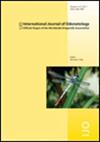安第斯山脉 Erythrodiplax abjecta(Rambur,1842 年)的繁殖行为
IF 1
4区 农林科学
Q3 ENTOMOLOGY
引用次数: 0
摘要
研究新热带物种的行为对于了解新热带地区快速的环境变化如何影响各种生物的繁殖至关重要。迄今为止,人们对热带生态系统中昆虫的繁殖行为知之甚少,例如蜻蜓目昆虫。本文描述了哥伦比亚安第斯山脉几个地点的 Erythrodiplax abjecta 的繁殖行为。该物种的雄性个体在 10:00 至 14:30 之间活动,可能表现出领地行为或卫星行为。性成熟的雄性和雌性有串联和交配行为,这些行为很短暂,可能发生在栖息或飞行中。雌鱼在不同时间直接在水中产卵,与休息时间交替进行。在产卵期间,雄性在雌性身边站岗,或栖息或盘旋,以保护雌性不受其他雄性的侵害。据观察,同种雄性会围攻栖息或产卵的雌性,也会围攻交配对。围攻之后,要么雌性或原配对逃离,要么围攻的雄性成功地击败了原雄性,与雌性共同占有雌性,与雌性交配,然后在雌性产卵时保护雌性。如果雌鸟逃走,它可能会在其他地方栖息,继续产卵,也可能被其他雄鸟叼走。雄鸟在产卵期间的强烈守护行为可能是为了适应产卵地点雄鸟暂时的高密度,以及在交配活跃的短时间内的高竞争水平。本文章由计算机程序翻译,如有差异,请以英文原文为准。
Reproductive behavior of Erythrodiplax abjecta (Rambur, 1842) from Andean Mountains
Research about the behavior of Neotropical species is crucial to understand how the rapid environmental changes in the Neotropics affect the reproduction of various organisms. The reproductive behavior of insects in tropical ecosystems, such as those belonging to the order Odonata, is as yet scarcely known. In this article, the reproductive behavior of Erythrodiplax abjecta is described from several localities in the Colombian Andean Mountains. Playing out between 10:00 and 14:30 h, male individuals of this species may exhibit either territorial or satellite behavior. Sexually mature males and females engage in tandem and copulation behaviors, which are brief and may occur either perched or in flight. Females of E. abjecta oviposit directly in the water at various times, alternating with periods of rest. During oviposition, males stand guard over females, perched or hovering, in a quest to protect them against other males. Conspecific males have been observed to engage in sieges of perching or ovipositing females, as well as mating pairs. Following a siege, either the female or the original pair flees, or the besieging male will succeed in outcompeting the original male, take the female in tandem, copulate with her, and then guard her while she oviposits. If the female flees, she may perch elsewhere, continue ovipositing, or may be taken by another male. The intense male guarding behavior during oviposition could represent an adaptation to temporarily high male densities at oviposition sites and a high level of competition during the short period in which active copulation takes place.
求助全文
通过发布文献求助,成功后即可免费获取论文全文。
去求助
来源期刊

International Journal of Odonatology
ENTOMOLOGY-
CiteScore
2.30
自引率
0.00%
发文量
15
审稿时长
>12 weeks
期刊介绍:
International Journal of Odonatology (IJO) is aimed at providing a publication outlet for the growing number of students of Odonata. It will address subjects such as the ecology, ethology, physiology, genetics, taxonomy, phylogeny and geographic distribution of species. Reviews will be by invitation, but authors who plan to write a review on a subject of interest to the journal are encouraged to contact the editor.
 求助内容:
求助内容: 应助结果提醒方式:
应助结果提醒方式:


